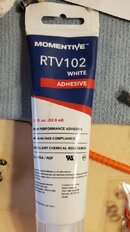Opened up and repaired in less time than it takes to get the cover off of an old “D” series.
104 completely extruded and on the shaft

Two smaller o rings still glued to shaft

104 still has silicone in the middle from glueing

New poppet dropped in and no leaks. I love how easy these are to work on.

104 completely extruded and on the shaft
Two smaller o rings still glued to shaft
104 still has silicone in the middle from glueing
New poppet dropped in and no leaks. I love how easy these are to work on.




